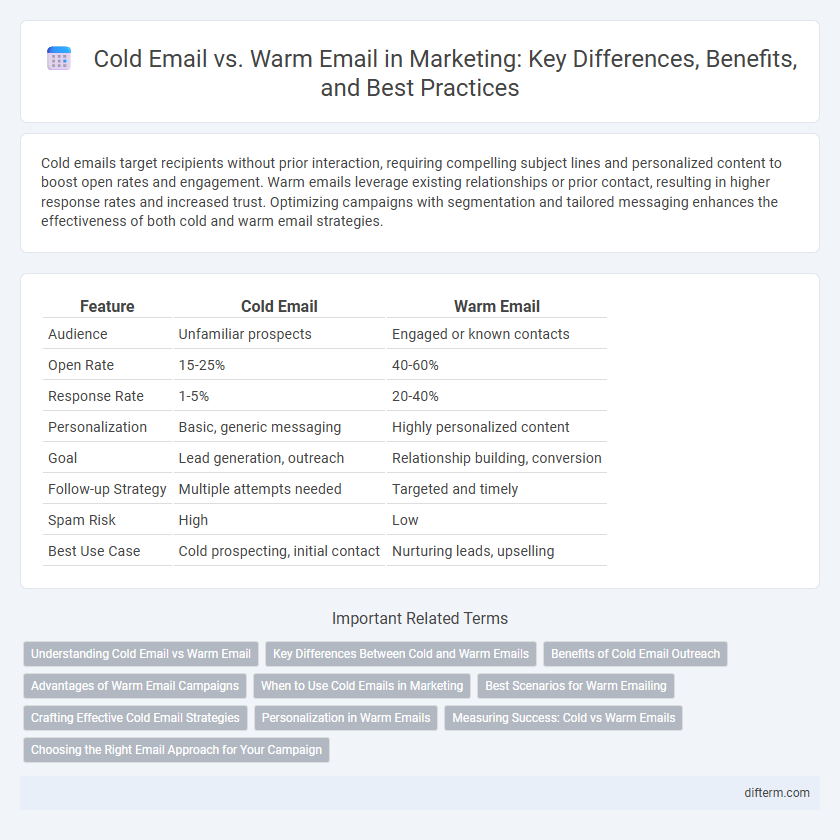Cold emails target recipients without prior interaction, requiring compelling subject lines and personalized content to boost open rates and engagement. Warm emails leverage existing relationships or prior contact, resulting in higher response rates and increased trust. Optimizing campaigns with segmentation and tailored messaging enhances the effectiveness of both cold and warm email strategies.
Table of Comparison
| Feature | Cold Email | Warm Email |
|---|---|---|
| Audience | Unfamiliar prospects | Engaged or known contacts |
| Open Rate | 15-25% | 40-60% |
| Response Rate | 1-5% | 20-40% |
| Personalization | Basic, generic messaging | Highly personalized content |
| Goal | Lead generation, outreach | Relationship building, conversion |
| Follow-up Strategy | Multiple attempts needed | Targeted and timely |
| Spam Risk | High | Low |
| Best Use Case | Cold prospecting, initial contact | Nurturing leads, upselling |
Understanding Cold Email vs Warm Email
Cold email targets recipients with no prior relationship, emphasizing concise, value-driven messaging to capture attention and generate interest. Warm email leverages existing connections or prior engagement, allowing for personalized content that builds trust and increases response rates. Understanding the fundamental differences helps marketers tailor their outreach strategies effectively for lead generation and customer conversion.
Key Differences Between Cold and Warm Emails
Cold emails target recipients with no prior interaction, relying heavily on persuasive subject lines and concise messaging to capture attention and generate leads. Warm emails engage contacts who have already shown interest or have an existing relationship, allowing for personalized content and higher open and response rates. Metrics like open rate, click-through rate, and conversion rate typically outperform in warm email campaigns due to relevance and familiarity.
Benefits of Cold Email Outreach
Cold email outreach enables marketers to expand their prospect base by reaching untapped audiences, increasing lead generation potential. It offers precise targeting capabilities through personalized messaging tailored to specific industries or pain points, enhancing engagement rates. Furthermore, cold emails are cost-effective, scalable, and measurable, allowing optimized campaign adjustments that maximize ROI.
Advantages of Warm Email Campaigns
Warm email campaigns generate higher open and response rates by targeting recipients familiar with your brand, fostering trust and engagement. Personalization in warm emails allows for tailored content that resonates with specific audience segments, enhancing conversion potential. Leveraging existing relationships in warm email marketing reduces the risk of being marked as spam, improving overall deliverability and campaign effectiveness.
When to Use Cold Emails in Marketing
Cold emails are most effective for reaching new prospects who have had no prior interaction with your brand, expanding your audience base quickly and efficiently. These emails should be used when targeting specific segments with tailored value propositions to generate initial interest and open dialogue. Leveraging personalized subject lines and clear calls to action increases response rates and transforms cold outreach into potential leads.
Best Scenarios for Warm Emailing
Warm emailing excels in scenarios where prior engagement exists, such as following up on webinar attendance or previous inquiries. It leverages established rapport, increasing open rates and response likelihood by personalizing content based on past interactions. Targeting warm leads nurtures relationships effectively, ultimately driving higher conversion rates compared to cold outreach.
Crafting Effective Cold Email Strategies
Cold email strategies require precise targeting and personalized messaging to engage recipients who have no prior relationship with the sender. Leveraging data-driven insights such as buyer personas, pain points, and behavior patterns enhances the relevance and conversion potential of outreach efforts. Employing concise subject lines, clear value propositions, and strong calls-to-action significantly improves open and response rates in cold email campaigns.
Personalization in Warm Emails
Warm emails achieve higher engagement rates through advanced personalization techniques, leveraging prior interactions, user behavior, and segmented data to tailor messages precisely to recipient needs. Unlike cold emails, which rely on generic templates, warm emails incorporate recipient-specific details such as recent purchases, browsing history, and expressed interests to foster trust and increase conversion rates. Effective personalization in warm email campaigns boosts open rates by up to 50% and click-through rates by nearly 14%, according to marketing analytics reports.
Measuring Success: Cold vs Warm Emails
Measuring success in cold versus warm email campaigns hinges on key performance indicators such as open rates, click-through rates, conversion rates, and response rates. Warm emails typically yield higher engagement metrics due to established relationships and prior interaction, while cold emails often require optimization in subject lines and personalization to improve performance. Tracking and analyzing these metrics through tools like CRM software and email marketing platforms enables marketers to refine strategies and maximize ROI for each email type.
Choosing the Right Email Approach for Your Campaign
Cold email campaigns target recipients with no prior interaction, requiring precise personalization and compelling subject lines to boost open rates. Warm email strategies leverage existing relationships or prior engagement, enhancing trust and increasing conversion potential through tailored content. Selecting the right approach depends on campaign goals, audience familiarity, and desired response rate to maximize marketing impact.
Cold Email vs Warm Email Infographic

 difterm.com
difterm.com